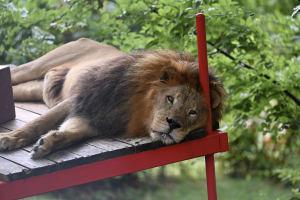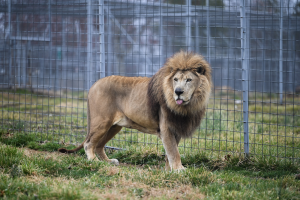
A male lion has one of the most identifiable features in the Feline family. Surrounding the head and neck, and sometimes running the length of their body, a male lion’s mane has them standing out from the crowd.
Mane Misconception
A common misconception about lion manes is that they are for protection in fights. When studying this perspective, scientists had to consider alternative methods to answering the question. Lion fights are rarely seen. It was determined that if manes were used for protection in fights, the mane area would have more, severe injuries. However, this was not found to be the case. Wounds found in the area of the mane were not more common or more deadly than wounds found anywhere else on the body. This data was also seen with female lions or young adult male lions.

Mane Theories
Two other theories proposed that the color and length of a lion’s mane indicated fighting ability and physiological condition. In general, male lions with higher testosterone levels had darker manes. They were, on average, better fed throughout the year. This could suggest that darker-maned lions are more dominant or have better hunting abilities over lighter-maned lions. When presented with fake calls of a female in heat, darker-maned lions tended to get to the female quicker. On the other hand, it was observed that females chose to mate with male lions with darker manes.
Less consistent information was found about the length of a lion’s mane. A male lion’s mane length could indicate fighting ability. A short mane was usually observed in connection to injury. Therefore, lions with longer manes didn’t get attacked as often, or they were more often victorious. Female lions seemed to prefer mane color over length. Male lions were seen avoiding males with longer manes. However, data gathered about mane length was not significant enough to draw solid conclusions.

Mane Drawbacks
Having a dark, long mane may indicate dominance, but it does have drawbacks. A male lion with a dark, long, thick mane can suffer from heat stress. Lions live in Africa, a place known for its very, very hot deserts. A study found that male lions had higher body temperatures than female lions and male lions with darker manes had the highest body temperatures. Comparing lions from the Tsavo National Park, an extremely hot, humid area, and the Serengeti, a cooler area, the Tsavo National Park male lions were almost maneless. Without a heavy, dark mane, the Tsavo National Park lions were seen to have a much cooler body temperature. A recurring connection was seen between the average temperature of the area and the length and darkness of the lion’s mane.
The style and color of a male lion’s mane can even denote which subspecies they belong to. At this time, there are 8 subspecies of lions. Based on their location and the temperatures they face, lion manes can be lighter or darker, longer or shorter, or traveling down the length of their chest or just around their face. Every lion is different!
TCWR is home to 3 male lions: Chief, Simba, and Tsavo. Each one has a unique mane, so come visit them and determine for yourself who’s king of the TCWR pride!

